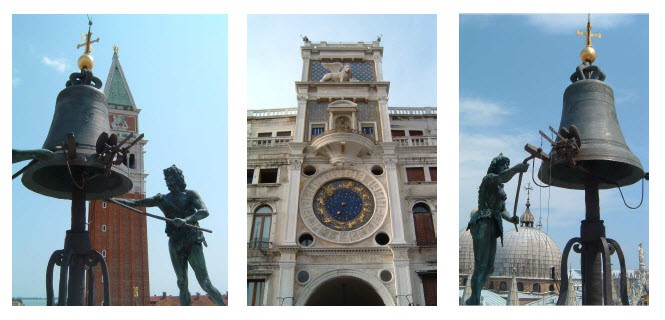The Restoration of the Moors
For over 500 years, the rich history of Venice and the life that flows through its streets, piazzas and canals has been marked by the magnificent astronomical clock of the Torre dell’Orologio. Perched high above the roofs of Venice, two grand figures have stood loyally either side of the clock’s bell, ringing in the hours by striking it with their hammers. Conscious of the importance of the great Venetian clocks in the history of watchmaking, Piaget has played an active role in the maintenance of these extraordinary horological landmarks. The Maison’s latest Venetian patronage project is the completion of the update of the famous Torre dell’Orologio: the restoration of the two statues of Moors, important symbols of Venice’s influence.
Venice’s long heritage as a centre of excellence for the arts and technological innovation mirrors Piaget’s purpose as a Maison dedicated for the past 140 years to the pursuit of perfection, reflected in “Perfection in Life”, its new global advertising campaign. Through the technological feats of its watchmaking and the aesthetics of its watch and jewellery creations, Piaget invites the most discerning seekers to discover the pieces, as well as experience unique moments in the most unique places. Celebrating Venice’s own historical passion for perfection and the exceptional experience it offers, Piaget has committed its watchmaking expertise and support to the restoration of Venice’s invaluable clocks since 1997, including the complete
restoration of the mechanism of the Tower Clock and the clock of the Palazzo Ducale.
Located on the north side of St Mark’s Square leading into the Merceria, the Tower Clock’s strategic positioning played an important role in the overall layout of the city: both a triumphal archway from the religious and political centre of Venice into the city’s main commercial artery, and a symbol of the wealth and might of the great city to anyone visiting from the sea. Both a monument to time and to the influence of Venice, the Tower Clock still dominates the city.
A masterpiece of engineering, the first clock was constructed in 1493 by Gian Carlo Ranieri and subsequently modified between the mid-16th and 19th centuries. Originally conceived as shepherds, the two imposing statues that dominate the structure have since been renamed the “Moors” by Venetians, because of the discoloration of the bronze over time in the Venice air. Each one has a distinctive role to play: the older Moor represents times passed by striking the bell two minutes before the hour, while the younger one strikes it two minutes after the hour
symbolizing times to come.
Recently, these figures have not been able to strike the hours consistently because of extensive wear and tear to the mechanism that allows them to pivot towards the great bell, still the original cast at the Arsenal in 1497. As the exclusive contributor to the maintenance and servicing of the mechanism of the clock of the Tower of Venice, Piaget has been invited once again by the Fondazione Musei Civici di Venezia to lend its expertise and financial support to the restoration of these Renaissance figures, so that for years to come, the clock will continue to keep perfect time with the chiming of its loyal Venetian Moors.

No Comments